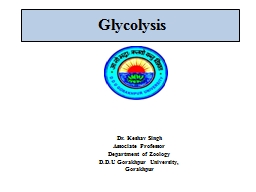

Associate Professor Department of Zoology DDU Gorakhpur University Gorakhpur GLYCOLYSIS Also known as Embden Meyerhof Parnas EMP pathway allows the metabolic use of glucose to generate ATP NADH and several biosynthetic precursors such as 3phosphoglycerate or ID: 1044888
Download Presentation The PPT/PDF document "Glycolysis Dr. Keshav Singh" is the property of its rightful owner. Permission is granted to download and print the materials on this web site for personal, non-commercial use only, and to display it on your personal computer provided you do not modify the materials and that you retain all copyright notices contained in the materials. By downloading content from our website, you accept the terms of this agreement.
1. GlycolysisDr. Keshav SinghAssociate ProfessorDepartment of ZoologyD.D.U Gorakhpur University,Gorakhpur
2. GLYCOLYSISAlso known as Embden-Meyerhof-Parnas (EMP) pathway allows the metabolic use of glucose to generate ATP, NADH, and several biosynthetic precursors such as 3-phosphoglycerate or pyruvate.An aerobic process.Takes place in the cytoplasm.After one molecule of glucose oxidation produces two molecule pyruvic acid.In anaerobic condition, in yeast cells fermentation takes place with help of alcohol dehydrogenase pyruvic acid convert in to ethylalcohol.In muscle cells pyruvic acid convert in to lactic acid due to lack of oxygen.In glycolysis production of 10 molecule ATP and loss of 2 molecule ATP, so total gain of 8 ATP molecule energy.In aerobic condition pyruvic acid inter in to mitochondria and kreb’s cycle started.
3. In Kreb’s cycle
4. Stage 1A phosphate group is added to glucose in the cell cytoplasm by the action of enzyme hexokinase.In this, a phosphate group is transferred from ATP to glucose forming glucose,6-phosphate
5. Stage 2Glucose-6-phosphate is isomerized into fructose,6-phosphate by the enzyme phosphoglucomutase
6. Stage 3The other ATP molecule transfers a phosphate group to fructose 6-phosphate and converts it into fructose 1,6-bisphosphate by the action of enzyme phosphofructokinase
7. Stage 4The enzyme aldolase converts fructose 1,6-bisphosphate into glyceraldehyde 3-phosphate and dihydroxyacetone phosphate, which are isomers of each other
8. Step 5Triose-phosphate isomerase converts dihydroxyacetone phosphate into glyceraldehyde 3-phosphate which is the substrate in the successive step of glycolysis.
9. Step 6This step undergoes two reactions:The enzyme glyceraldehyde 3-phosphate dehydrogenase transfers 1 hydrogen molecule from glyceraldehyde phosphate to nicotinamide adenine dinucleotide to form NADH + H+. Glyceraldehyde 3-phosphate dehydrogenase adds a phosphate to the oxidized glyceraldehyde phosphate to form 1,3-bisphosphoglycerate
10. Step 7Phosphate is transferred from 1,3-bisphosphoglycerate to ADP to form ATP with the help of phosphoglycerokinase. Thus two molecules of phosphoglycerate and ATP are obtained at the end of this reaction
11. Step 8The phosphate of both the phosphoglycerate molecules is relocated from the third to the second carbon to yield two molecules of 2-phosphoglycerate by the enzyme phosphoglyceromutase.
12. Step 9The enzyme enolase removes a water molecule from 2-phosphoglycerate to form phosphoenolpyruvate
13. Step 10A phosphate from phosphoenolpyruvate is transferred to ADP to form pyruvate and ATP by the action of pyruvate kinase. Two molecules of pyruvate and ATP are obtained as the end products.
14. In aerobic condition pyruvic acid inter in to mitochondria and kreb’s cycle started. In anaerobic condition, in yeast cells fermentation takes place with help of alcohol dehydrogenase pyruvic acid convert in to ethylalcohol. In muscle cells pyruvic acid convert in to lactic acid due to lack of oxygen.
15. REFRENCEShttp//en.wikipedia org MICROBIOLOGYINFO.COMGOOGLEBYJU’S ONLINE.comH.R. Singh and Neeraj Kumar.Animal Physiology and Biochemistry.Vishal publishing Co.JalandharDr.V.K.Tyagi (2005)Animal Physiology and bio chemistry.Kedar nath Ram Nath ,Meerut.Dr. Ramesh Gupta..Modern Zoology a text book, Prakash Publication MuzaffnagarA.Guyton and J.E. Hall.(2010) Text book of Medical Physiologyhttps://google.comhttps://biologydictionary.net/krebs-cycle/https://www.britannica.com/science/tricarboxylic-acid-cyclehttps://microbiologyinfo.com/krebs-citric-acid-cycle-steps-by-steps-explanation/https://www.kau.edu.sa/Files/0002526/files/20209_citric_acid%5B1%5D.pdffile:///C:/Users//Downloads/Ch-20citricacidcycle.pdfhttps://www.sciencedirect.com/topics/engineering/krebs-cycle#:~:text=The%20citric%20acid%20cycle%20(also,of%20adenosine%20triphosphate%20(ATP)Jain JL, Jain S, and Jain N (2005). Fundamentals of Biochemistry. S. Chand and Company.Nelson DL and Cox MM. Lehninger Principles of Biochemistry. Fourth Edition.Berg JM et al. (2012) Biochemistry. Seventh Edition. W. H Freeman and Company.Berg JM, Tymoczko JL, Stryer L. Biochemistry. 5th edition. New York: W H Freeman; 2002. Section 17.2, Entry to the Citric Acid Cycle and Metabolism Through It Are Controlled. Available.https://en.wikipedia.org/wiki/Hering%E2%80%93Breuer_reflexwww.goole.comwww.goole.co. in